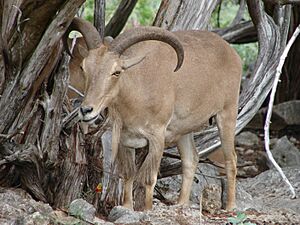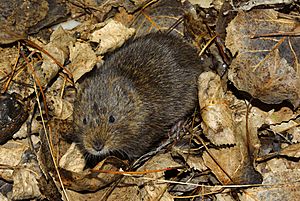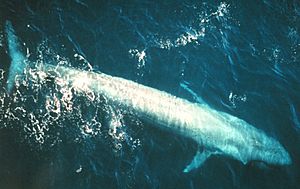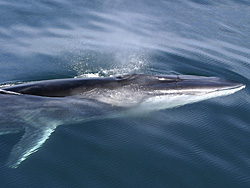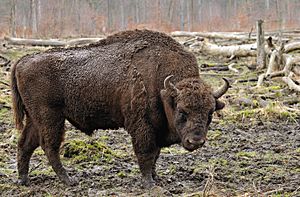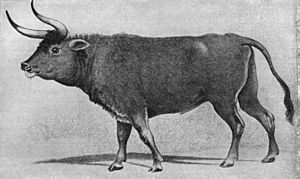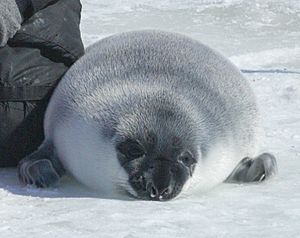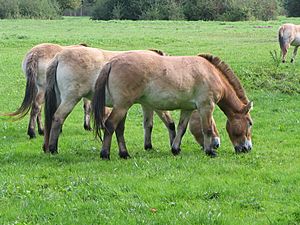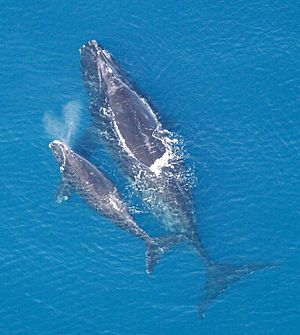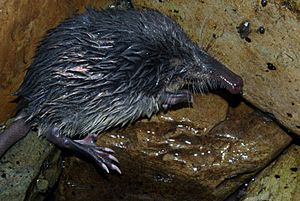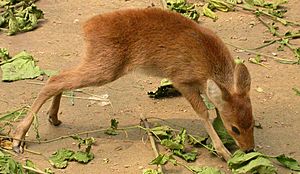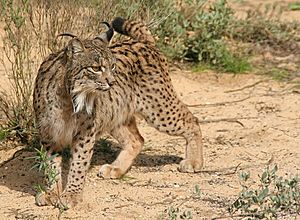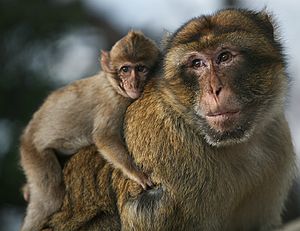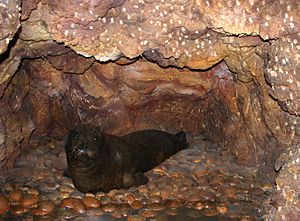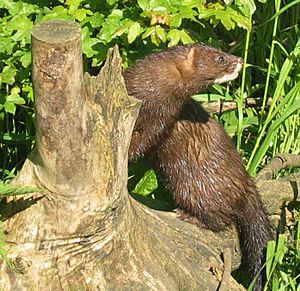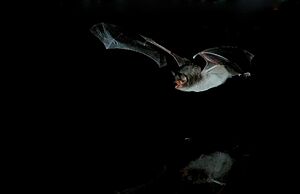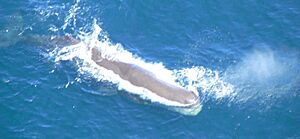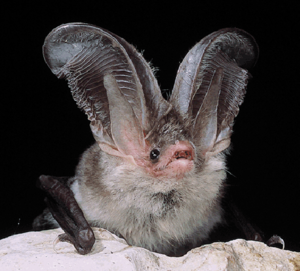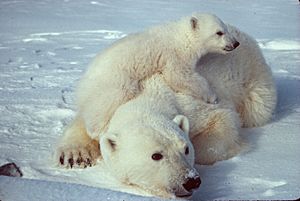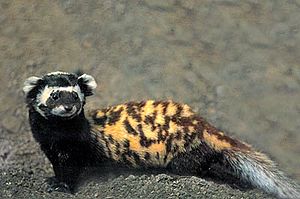Threatened mammals of Europe facts for kids
Threatened mammals are amazing animals that need our help! They live in or visit different parts of Europe, the East Atlantic Ocean, and nearby islands. This includes places like Iceland, the Mediterranean Sea, and even parts of Russia.
This list comes from the IUCN Red List of Endangered Species (IUCN). The International Union for Conservation of Nature is a group that helps find animals and plants that are in danger of disappearing forever. They work hard to protect these species before it's too late.
Animals on this list are grouped by how much danger they are in:
- Vulnerable (VU): These animals are likely to become endangered if we don't protect them.
- Endangered (EN): These animals are at high risk of disappearing from the wild.
- Critically Endangered (CR): These animals are in extreme danger and could disappear very soon.
- Extinct (EX): Sadly, these animals have already disappeared completely from Earth.
Contents
- Critically Endangered Mammals
- Endangered Mammals
- Vulnerable Mammals
- Barbary Sheep
- Southwestern Water Vole
- European Bison
- Cretan White-toothed Shrew
- Hooded Seal
- Pyrenean Desman
- Chinese Water Deer
- Broom Hare
- Corsican Hare
- Roach's Mouse-tailed Dormouse
- Long-fingered Bat
- Sperm Whale
- Sardinian Long-eared Bat
- Mehely's Horseshoe Bat
- European Ground Squirrel
- Polar Bear
- European Marbled Polecat
- Extinct Mammals
- See also
Critically Endangered Mammals
These animals are in the most danger. They need urgent help to survive.
Bavarian Pine Vole
- Scientific name: Microtus bavaricus
- This small rodent lives in Austria. It used to live in Germany too.
- It's critically endangered because its home is shrinking.
European Mink
- Scientific name: Mustela lutreola
- This furry animal lives in parts of France, Romania, Russia, Spain, and Ukraine.
- It has disappeared from many other European countries.
Mongolian Saiga
- Scientific name: Saiga tatarica
- This unique antelope lives in Kazakhstan, Mongolia, Russia, and other Central Asian countries.
- It's critically endangered due to hunting and habitat loss.
Endangered Mammals
These animals face a very high risk of disappearing in the wild.
Sei Whale
- Scientific name: Balaenoptera borealis
- This large whale lives in oceans all over the world, including parts of the Atlantic.
- It was heavily hunted in the past.
Blue Whale
- Scientific name: Balaenoptera musculus
- The blue whale is the largest animal on Earth. It lives in all oceans.
- Like the sei whale, it was hunted a lot, making it endangered.
Fin Whale
- Scientific name: Balaenoptera physalus
- This is the second-largest whale. It lives in oceans worldwide.
- It's endangered due to past whaling.
Przewalski's Horse
- Scientific name: Equus ferus przewalskii
- This wild horse used to live across many parts of Europe and Asia.
- It was once extinct in the wild but has been reintroduced to Mongolia.
North Atlantic Right Whale
- Scientific name: Eubalaena glacialis
- This whale lives in the North Atlantic Ocean, near Canada and the United States.
- It's one of the most endangered large whales.
Canarian Shrew
- Scientific name: Crocidura canariensis
- This tiny shrew is found only on the Canary Islands in Spain.
- Its small home makes it very vulnerable.
Iberian Lynx
- Scientific name: Lynx pardinus
- This beautiful wild cat lives in Spain and possibly Portugal.
- It's one of the most endangered cat species in the world.
Barbary Macaque
- Scientific name: Macaca sylvanus
- This monkey lives in Algeria and Morocco. There's also a group in Gibraltar.
- Their numbers are decreasing due to habitat loss.
Mediterranean Monk Seal
- Scientific name: Monachus monachus
- This seal lives in parts of the Mediterranean Sea and the Atlantic coast of Africa.
- It's one of the rarest marine mammals.
Azores Noctule
- Scientific name: Nyctalus azoreum
- This bat is found only on the Azores islands, which belong to Portugal.
- It's endangered because it lives in a very small area.
Madeira Pipistrelle
- Scientific name: Pipistrellus maderensis
- This small bat lives on the Madeira and Canary Islands.
- It's endangered due to its limited habitat.
Tenerife Long-eared Bat
- Scientific name: Plecotus teneriffae
- This bat is found only on the Canary Islands, specifically Tenerife.
- Its small population and specific habitat make it endangered.
Vulnerable Mammals
These animals are likely to become endangered if conservation efforts don't continue.
Barbary Sheep
- Scientific name: Ammotragus lervia
- Also known as Aoudad, this wild sheep lives in North Africa. It has been introduced to Spain.
- It's vulnerable in its native range.
Southwestern Water Vole
- Scientific name: Arvicola sapidus
- This vole lives in France, Portugal, and Spain.
- Its wetland habitats are threatened.
European Bison
- Scientific name: Bison bonasus
- This large animal lives in forests in Belarus, Poland, Russia, and other European countries.
- It was once nearly extinct but has been brought back through conservation.
Cretan White-toothed Shrew
- Scientific name: Crocidura zimmermanni
- This shrew is found only on the island of Crete in Greece.
- Its small island home makes it vulnerable.
Hooded Seal
- Scientific name: Cystophora cristata
- This seal lives in the North Atlantic Ocean, around Canada, Greenland, and Norway.
- It's vulnerable due to hunting and climate change affecting its ice habitat.
Pyrenean Desman
- Scientific name: Galemys pyrenaicus
- This unique, semi-aquatic mammal lives in the Pyrenees mountains of Andorra, France, Portugal, and Spain.
- It's vulnerable due to pollution and habitat changes in its rivers.
Chinese Water Deer
- Scientific name: Hydropotes inermis
- Native to China and Korea, this deer has been introduced to France and the United Kingdom.
- It's vulnerable in its native range.
Broom Hare
- Scientific name: Lepus castroviejoi
- This hare is found only in Spain.
- Its specific habitat makes it vulnerable.
Corsican Hare
- Scientific name: Lepus corsicanus
- This hare lives in Italy (Sicily) and possibly Corsica, France.
- It's vulnerable due to habitat loss and hunting.
Roach's Mouse-tailed Dormouse
- Scientific name: Myomimus roachi
- This small rodent lives in Bulgaria, Greece, and Turkey.
- It's vulnerable due to habitat changes.
Long-fingered Bat
- Scientific name: Myotis capaccinii
- This bat lives around the Mediterranean Sea in many countries.
- It's vulnerable due to habitat loss and disturbance in its caves.
Sperm Whale
- Scientific name: Physeter macrocephalus
- The largest toothed whale, it lives in all deep oceans worldwide.
- It's vulnerable due to past whaling and current threats like ship strikes.
Sardinian Long-eared Bat
- Scientific name: Plecotus sardus
- This bat is found only on the island of Sardinia, Italy.
- Its very limited range makes it vulnerable.
Mehely's Horseshoe Bat
- Scientific name: Rhinolophus mehelyi
- This bat lives in many countries around the Mediterranean and into Asia.
- It's vulnerable due to habitat loss and human disturbance.
European Ground Squirrel
- Scientific name: Spermophilus citellus
- This squirrel lives in Central and Eastern Europe.
- Its grasslands are shrinking, making it vulnerable.
Polar Bear
- Scientific name: Ursus maritimus
- These iconic bears live in the Arctic regions of Canada, Greenland, Norway, Russia, and the United States.
- They are vulnerable because climate change is melting their sea ice home.
European Marbled Polecat
- Scientific name: Vormela peregusna
- This polecat lives across Eastern Europe and parts of Asia.
- It's vulnerable due to habitat loss and changes in its prey.
Extinct Mammals
These animals have sadly disappeared forever.
Aurochs
- Scientific name: Bos primigenius primigenius
- This was a very large type of wild cattle that lived across Europe, Asia, and North Africa.
- The last known aurochs died in Poland in 1627.
Sardinian Pika
- Scientific name: Prolagus sardus
- This small rabbit-like mammal lived on the islands of Corsica (France) and Sardinia (Italy).
- It became extinct around the late 1700s or early 1800s.
See also
- Endangered plants of Europe
- IUCN Red List


